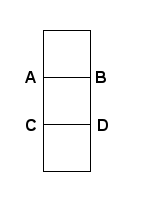Here's my full solution to RGamma's problem, without the two numbers specified beforehand, and without any prior assumption that a solution exists or that it is unique:
In this post, "factorization" means writing n=cd with c,d in [2,99] and c≤d.
"Two factorizations" means "at least two factorizations".
Clearly, S must be at least 4 for this problem to make sense.
Let x,y be two integers in [2,99] with x≤y, xy=P with P given to Mr. Product, x+y=S with S given to Mr. Sum.
Mr. Product: "I know neither of both numbers."
That means P has at least two factorizations.
Mr. Sum: "I, too, know neither of both numbers; but I knew that you wouldn't know them."
That means for all c,d in [2,99] with c+d=S, cd has two factorizations.
S<55 since otherwise if c=S-53, d=53, then cd has only one factorization.
S is odd, since all even numbers in [4,54] are the sum of two primes (just take my word for it).
S-2 is composite, since otherwise if c=2, d=S-2, then cd has only one factorization.
Furthermore, if S-2 is composite, then S is consistent with Mr. Sum's statement. This is because if c+d=S, with c,d in [3,50], one of c,d is even and the other is odd. Without loss of generality, c is even, so c=2e, e>1. As well, d≤49. Then cd=e(2d) and so cd has two factorizations. If c=2, d=S-2, then since S-2 is composite, cd has two factorizations.
Therefore S must be one of the numbers of the set {11, 17, 23, 27, 29, 35, 37, 41, 47, 51, 53}. Call this set V.
Mr. Product: "Now I know both numbers."
That means there is exactly one factorization of P into cd such that c+d is in V. Let W be the set of all integers x for which there is exactly one factorization of x into cd such that c+d is in V.
Mr. Sum: "Now I know both numbers as well."
That means that, over the set of all pairs (c,d) with c+d=S and c≤d, there is exactly one pair (c0, d0) with c0d0 in W.
Suppose S>33. If c=S-29, d=29, then cd is in W. Similarly, if c=S-31, d=31, then cd is in W. This is inconsistent with Mr. Sum's second statement. Therefore S is one of {11, 17, 23, 27, 29}.
Furthermore, any number of the form q(2m), where q is an odd prime and m>1, and with q+2m in V, is in W, since c=q, d=2m is the only factorization with c+d odd.
We see that 11=3+8=7+4, 23=19+4=7+16, 27=23+4=19+8, and so 11, 23, and 27 have more than one representation as c+d with c≤d such that cd is in W, so we can get rid of them. S is either 17 or 29.
Note that 29=13+16. Now for 4,25 (29=4+25), we see that 100 is in W since the only factorizations with one odd and one even are 4,25 and 20,5, and 20+5=25 is not in V. Therefore S cannot be 29, so S=17.
Now 17=13+4, and 13(4)=52 is in W. The other possibilities for c+d=17 are ruled out as follows:
17=2+15, 2(15)=6(5), 6+5=11 is in V.
17=3+14, 3(14)=21(2), 21+2=23 is in V.
17=5+12, 5(12)=20(3), 20+3=23 is in V.
17=6+11, 6(11)=2(33), 2+33=35 is in V.
17=7+10, 7(10)=35(2), 35+2=37 is in V.
17=8+9, 8(9)=24(3), 24+3=27 is in V.
So none of the other pairs (c,d) have cd in W. This gives the two numbers for the unique answer, x=4 and y=13.





 If you look closely at the two vertical roads AC and BD and consider when to travel them and what to do in between, I doubt you'll find a true circle, but I still lack rigorous proof.
If you look closely at the two vertical roads AC and BD and consider when to travel them and what to do in between, I doubt you'll find a true circle, but I still lack rigorous proof.












